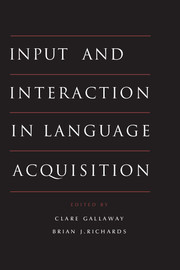Conclusions and directions
Published online by Cambridge University Press: 05 June 2012
Summary
Introduction
In her Introduction to this volume, Snow has commented on the huge volume of research carried out in the area of input and interaction in recent years. In each of our chapters, the facts and implications of a particular area of this vast body of research have been drawn together. It remains to consider how our current understanding of the issues has been increased by the contributions.
A common criticism leveled against studies of children's language acquisition is that theoretical frameworks proposed for individual areas may shed light on those areas but may be less enlightening for others; for example, an explanatory theory for certain phonological facts may bear no relation to any sort of theory devised to explain semantic phenomena. The chapters collected in this book cover a number of aspects of input and interaction, and the question of what is, or is not, viewed as significant varied according to the area studied. In her Introduction, Snow has drawn attention to the fractionation of the research field. We need, therefore, to seek consensus amongst researchers to make some general statements, and this volume, we hope, has served as a forum for drawing together differing perspectives.
- Type
- Chapter
- Information
- Input and Interaction in Language Acquisition , pp. 253 - 269Publisher: Cambridge University PressPrint publication year: 1994
- 3
- Cited by



